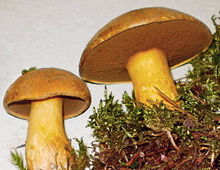Suillus variegatus
| Suillus variegatus | |
|---|---|

| |
| Scientific classification | |
| Domain: | Eukaryota |
| Kingdom: | Fungi |
| Division: | Basidiomycota |
| Class: | Agaricomycetes |
| Order: | Boletales |
| Family: | Suillaceae |
| Genus: | Suillus |
| Species: | S. variegatus
|
| Binomial name | |
| Suillus variegatus | |
| Synonyms | |
|
Boletus variegatus Sw. (1810) | |
| Suillus variegatus mycorrhizal | |
|---|---|
| Edibility is edible | |
Suillus variegatus, commonly called the velvet bolete or variegated bolete, is a species of
.Description
The
Scleroderma).[2]
The variegatic acid is an orange pigment first isolated from Suillus variegatus.[3] It has strong antioxidant properties,[4][5] and a nonspecific inhibitory effect on cytochrome P450 enzymes.[6] When mushroom tissue containing variegatic acid is exposed to air, the chemical is enzymatically oxidized to blue quinone methide anions.[7]
Distribution and habitat
Suillus variegatus appears frequently with, and is
pine trees in late summer. It is often found with heathers, and other acid loving plants, on sandy soils. It is widespread in Europe, nearer parts of Asia,[2] and North America
.
Edibility
Suillus variegatus is edible, but is said to smell unpleasant, with a somewhat metallic taste.[2] It was one of the most productive edible wild mushroom species in Finland in the 1970s.[8]

References
- ISBN 0-330-44237-6.
- ^ ISBN 0-7513-1070-0.
- .
- .
- S2CID 84061662.
- S2CID 39654350.

- .
- JSTOR 23726151.
 Media related to Suillus variegatus at Wikimedia Commons
Media related to Suillus variegatus at Wikimedia Commons
